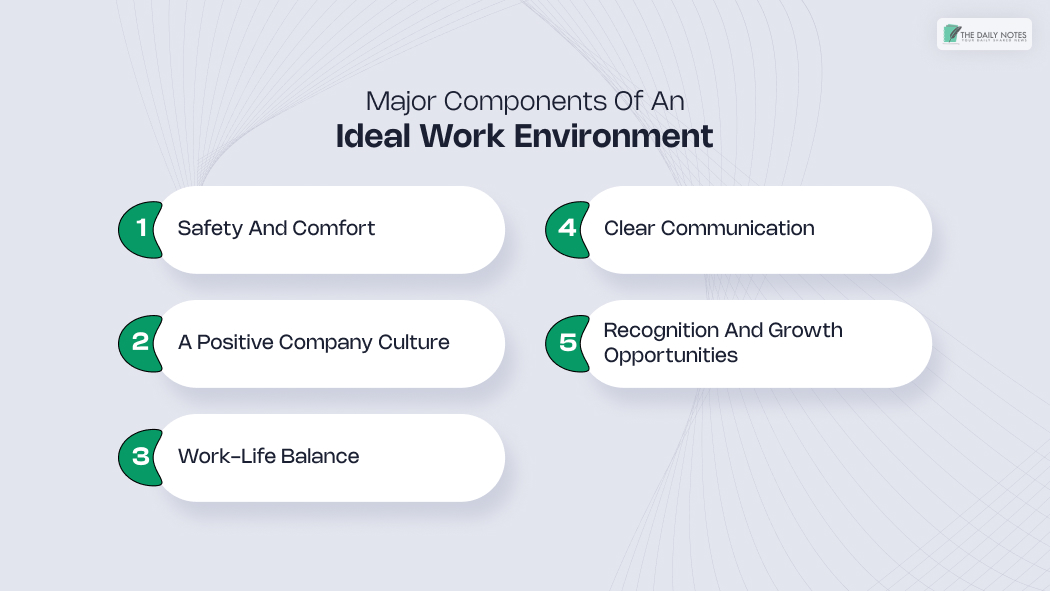What is an ideal work environment? We often find ourselves asking this question, usually when the HR Department comes to us for feedback. So, here we present 50 answers on an ideal work environment to help change things in your workspace.
An ideal work environment fosters productivity and overall employee and job satisfaction. Various factors contribute to both the physical and psychological needs of employees.
Promoting a space where they can contribute effectively to the organization’s success through a healthy environment promotes corporate wellness. Consequently, these are important for the employee’s professional growth.
Let’s explore the components first!
Major Components of an Ideal Work Environment – What Makes it Work?

An ideal work environment is something that all employees yearn for. This is not a utopian concept but a reality that so many people live! The following section looks at the different components employees that must be present for an ideal environment!
Here are the components of an ideal work environment:
Safety and Comfort

The primary element of an ideal work environment is ensuring the physical safety and comfort of the employees. This includes everything from well-ventilated spaces to ergonomic furniture and a clean and organized workspace.
A safe and comfortable environment shows that employees are confident in the workspace and are without fear of any health or safety concerns. Moreover, maintaining such standards will ensure that the workplace adheres to health and safety regulations.
Thus, minimizing or preventing the risk of illness or injury. This caters for the employees’ emotional safety as well.
They feel free to express their concerns, issues, and ideas without fear of retribution, which creates an open and positive environment. Moreover, this helps critical incident stress management by providing necessary support.
A Positive Company Culture

A positive and healthy company culture is the foundation of an ideal work environment. Thus, a strong culture emphasizes open communication, shared values, a sense of belonging, and respect for diversity.
When employees connect with the values and mission of the company, they are more likely to experience better engagement and motivation to work effectively.
Leadership is another component of an ideal work environment that embodies company culture. This is a critical aspect as leaders inspire, promote inclusivity, and listen to feedback within the workplace.
Work-Life Balance

Many employees believe that work-life balance is a myth, but that’s not the case. An ideal environment maintains a proper work-life balance. When employees have the flexibility to balance their professional and personal lives and responsibilities, they are more likely to remain productive as they are physically, mentally, and emotionally sound.
Flexible work schedules allow employees to maintain a healthy balance between their personal lives and work.
For instance, you can offer adequate time to work remotely or another flexible work schedule model to help accomplish this.
A work environment where the importance of personal well-being is recognized helps increase employee satisfaction and loyalty.
Clear Communication

Effective communication forms a crucial part of any thriving work environment, so why should the ideal work environment not be able to communicate effectively?
Transparent, open communication across different levels of the organization prevents misunderstandings, thereby encouraging collaboration.
One-on-one check-ins, regular team meetings, and clear channels for feedback allow employees to feel understood and heard.
Moreover, with your communication, employees stay aligned with company expectations and goals, fostering a sense of direction and purpose.
Recognition and Growth Opportunities

Employees must feel valued and see that their efforts contribute to the organization’s success. Moreover, this helps them feel that their efforts are valued and that they have growth opportunities within the organization.
You can provide career development programs, opportunities to learn new skills, and mentorship, which allows employees to upskill. When you recognize and reward employees efforts and achievements.
It fosters a sense of pride and motivation for them, which leads to greater job retention and satisfaction.
50 Answers on Ideal Work Environment Shows Where we are Going Wrong

These questions and answers help highlight common issues organizations may face in building a positive work environment:
Often, employees hesitate to express concerns because past feedback may have been ignored or met with retaliation, showing where communication culture needs improvement.
If management consistently brushes off feedback or becomes defensive, it indicates a lack of openness that stifles innovation and trust.
In many organizations, diversity initiatives are surface-level, with no real efforts to build inclusivity into the daily culture. Thus, this creates an environment where minority groups feel sidelined.
When companies fail to foster strong internal relationships and team-building, employees may feel isolated and disconnected from the company’s mission.
In some organizations, flexibility is offered only to senior or select staff, which can breed resentment and highlight inequities in company policy.
Despite talk of work-life balance, many employees feel pressured to respond to emails outside of hours, blurring boundaries and leading to burnout.
When leadership is distant and disengaged from everyday operations, they miss critical insights from employees who know the business best.
Lack of acknowledgment for efforts is a common issue that can lower morale and motivation. Recognition programs, when lacking, can reveal a leadership blind spot.
In many cases, high-potential employees receive ample growth opportunities, while others need to be included, showing an unequal development structure.
Despite growing awareness, many workplaces still fail to provide adequate mental health support, viewing employees more as resources than individuals.
Miscommunication often arises when teams don’t have formal processes for sharing updates, leading to inefficiencies and a lack of cohesive strategy.
Without transparency from leadership on company goals, employees can feel disconnected. Consequently, they can be unsure about their role in the company’s future.
Excessive micromanagement stifles creativity, showing a lack of trust in employees. In addition, it contributes to frustration and disengagement.
Uncomfortable seating or poorly designed workspaces demonstrate a need for more attention to employee well-being. Consequently, this leads to health issues or decreased productivity.
When employees are not consulted on decisions that directly impact their tasks, it shows a top-down approach that alienates staff and reduces job satisfaction.
A lack of diversity in leadership shows that the company’s commitment to inclusion may not extend beyond entry-level positions. Thus, limiting diverse perspectives at the top.
Outdated or insufficient benefits packages show that companies need to be in touch with what employees consider important, such as healthcare, mental wellness programs, or family leave.
When collaboration tools and structures are lacking, employees may struggle to work together effectively, leading to siloed work and reduced innovation.
Leaders who are inaccessible can create an “us vs. them” mentality. As a result, this has led to a lack of trust and fewer opportunities for employee feedback.
When employees see no tangible impact from their work, motivation wanes, leading to disengagement and high turnover.
Unstructured or irregular feedback leaves employees uncertain about their performance and growth, showing a gap in leadership development practices.
A culture of favoritism undermines morale and causes frustration, as employees perceive that hard work isn’t rewarded fairly.
Lack of investment in technology creates inefficiencies. Thereby, making it harder for employees to be productive and highlighting poor resource management.
When workloads aren’t distributed evenly, it can lead to burnout for some employees, while others may feel underutilized, showing poor managerial oversight.
Ignoring sustainability trends or failing to implement socially responsible practices can alienate employees who prioritize working for ethical organizations.
Companies that ignore the signs of burnout or fail to offer proactive solutions reveal a lack of care for long-term employee well-being.
Micromanagement reveals a lack of trust in employee judgment and discourages innovation and accountability within the team.
Training limited to compliance rather than development for future growth shows a lack of investment in long-term employee success.
Open offices with constant noise, poor lighting, or cramped spaces reveal a disconnect between leadership’s ideas and employees’ needs.
When policies exist on paper but not in practice, employees feel unsupported, and this shows where leadership is failing to create a safe work environment
When employees don’t see a clear path to advancement, they may feel stagnant, which leads to dissatisfaction and high turnover rates.
A biased hiring process alienates potential talent and creates resentment among current employees who feel diversity and inclusion should be prioritized.
A lack of team-building activities can create silos between employees, weakening collaboration and overall team dynamics.
Micromanagement shows a lack of trust in employees and can lead to frustration and decreased creativity.
A slow response to industry trends can leave employees feeling unprepared and frustrated with outdated practices.
Collecting feedback without acting on it sends a message that employee opinions don’t matter, reducing engagement.
Poor conflict resolution can create tension in the workplace. As a result, it affects morale and productivity.
Opaque compensation and promotion processes can lead to feelings of inequality and dissatisfaction among employees. Thus, it is better to have proper policies to prevent this.
Leaders who fail to lead by example create a culture of mistrust and disengagement. In addition, this leads to poor employee engagement and job satisfaction.
Employees may struggle with stress and burnout when companies are rigid about working hours or personal time off.
Wellness programs should be meaningful and accessible, consequently, these are not just corporate buzzwords that lack real impact.
Neglecting soft skills development can result in poor communication, low emotional intelligence, and ineffective team dynamics.
A hyper-competitive atmosphere can breed resentment and discourage collaboration, while mutual respect fosters a supportive environment.
A poorly designed onboarding process can leave new employees feeling lost, unprepared, and disconnected from the team.
If managers focus on deadlines and deliverables, employees may feel more valued and supported in their personal development.
In addition, managers must create an environment where feedback is easy to share.
Organizations that ignore burnout risk losing top talent, as overworked employees eventually disengage or leave.
Overlooking internal talent for external hires can lead to frustration and decreased loyalty among employees seeking career progression.
Inflexible work arrangements can decrease job satisfaction, especially when remote work has proven to be productive for many employees.
A resistance to learning new skills and evolving as a team can leave employees feeling unchallenged and stagnant in their careers. Therefore, you must foster a learning culture in the workspace.
When annual reviews lack substance or actionable feedback, employees may feel that their performance could be better evaluated or valued. Thus, annual reviews should receive a better plan of action. This will help avoid meaningless reviews.
Wrapping It Up!
Hopefully these 50 questions and answers help clarify the requirements of an ideal work environment. These answers were curated from 50 employees across different organizations.
Employee satisfaction greatly influences engagement and productivity which can eventually drive revenue. So, is your company vying for an ideal work environment?
You May Like Also:




























